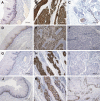Prognostic value of SOX2, Cyclin D1, P53, and ki-67 in patients with esophageal squamous cell carcinoma
- PMID: 30210237
- PMCID: PMC6114475
- DOI: 10.2147/OTT.S160066
Prognostic value of SOX2, Cyclin D1, P53, and ki-67 in patients with esophageal squamous cell carcinoma
Abstract
In this study, we evaluated SOX2, Cyclin D1, p53, and ki-67 expression immunohistochemically in 117 samples of surgically resected esophageal squamous cell carcinoma (ESCC) and matched normal tumor adjacent tissues and correlated the expression with clinicopathological finding and patient survival. Lymph node metastasis was observed in 36.8% of patients, and organ metastasis was observed in 17.9%. We detected high expression of SOX2, Cyclin D1, p53, and ki-67 in 46.1%, 70.1%, 54.7%, and 32.5% of ESCC tissues, respectively. SOX2 is localized in the tumor cell nuclei, and its expression was significantly associated with N stage (p=0.034) and differentiation (p=0.003) and ki-67 expression (p=0.001), whereas increased Cyclin D1 expression was correlated with high p53 (p=0.015). With regard to survival, we found that ESCC patients with high SOX2 expression had significantly better survival time than those with low SOX2 expression (p=0.021). A multivariate Cox analysis revealed that therapy and high p53 expression and venous invasion were independent predictors of unfavorable prognosis in overall survival (p=0.039, p=0.004, and p=0.023, respectively). Furthermore, higher T stage, clinical stage (pTNM), venous invasion, and high p53 expression were independent predictors of a worse progression-free survival. Notably, co-overexpression of p53 and Cyclin D1 was significantly correlated with poor overall survival and progression-free survival (p=0.029 and p=0.0227, respectively). Therefore, SOX2 might be considered as a potential prognostic indicator and a potential target for therapeutic targets in ESCC. p53 staining and combined p53 and Cyclin D1 expression had significantly unfavorable prognostic value for patients with ESCC. These findings provide more insight into ESCC; thus, further investigations into molecular mechanisms of drug resistance are essential.
Keywords: Cyclin D1; SOX2; esophageal squamous cell carcinoma; ki-67; p53; prognosis.
Conflict of interest statement
Disclosure The authors report no conflicts of interest in this work.
Figures






Similar articles
-
Clinicopathological significance of cancer stem cell marker CD44/SOX2 in esophageal squamous cell carcinoma (ESCC) patients and construction of a nomogram to predict overall survival.Transl Cancer Res. 2024 Jun 30;13(6):2971-2984. doi: 10.21037/tcr-23-2313. Epub 2024 May 30. Transl Cancer Res. 2024. PMID: 38988936 Free PMC article.
-
Evaluation of tumor metastasis-associated markers for molecular classification in patients with esophageal squamous cell carcinoma.Int J Clin Exp Med. 2015 Sep 15;8(9):15920-9. eCollection 2015. Int J Clin Exp Med. 2015. PMID: 26629095 Free PMC article.
-
Prognostic value of cyclin B1 in patients with esophageal squamous cell carcinoma.Cancer. 2002 Jun 1;94(11):2874-81. doi: 10.1002/cncr.10542. Cancer. 2002. PMID: 12115375
-
Expression of cyclin D1, Ki-67 and PCNA in non-small cell lung cancer: prognostic significance and comparison with p53 and bcl-2.Acta Histochem. 2000 Aug;102(3):323-38. doi: 10.1078/s0065-1281(04)70039-2. Acta Histochem. 2000. PMID: 10990069
-
Prognostic significance of biologic factors in squamous cell carcinoma of the esophagus.Cancer. 1999 Oct 15;86(8):1396-405. doi: 10.1002/(sici)1097-0142(19991015)86:8<1396::aid-cncr3>3.0.co;2-h. Cancer. 1999. PMID: 10526265
Cited by
-
Comparative Analysis of Clinicopathological Characteristics, Survival Features, and Protein Expression Between Basaloid and Squamous Cell Carcinoma of the Esophagus.Int J Gen Med. 2021 Jul 26;14:3929-3939. doi: 10.2147/IJGM.S314054. eCollection 2021. Int J Gen Med. 2021. PMID: 34345181 Free PMC article.
-
MAGE-A3 is a prognostic biomarker for poor clinical outcome in cutaneous squamous cell carcinoma with perineural invasion via modulation of cell proliferation.PLoS One. 2020 Nov 23;15(11):e0241551. doi: 10.1371/journal.pone.0241551. eCollection 2020. PLoS One. 2020. PMID: 33227008 Free PMC article.
-
Cancer stem-like cells contribute to paclitaxel resistance in esophageal squamous cell carcinoma.Int J Clin Exp Pathol. 2022 Apr 15;15(4):183-190. eCollection 2022. Int J Clin Exp Pathol. 2022. PMID: 35535205 Free PMC article.
-
Bioinformatics-based analysis of the lncRNA-miRNA-mRNA and TF regulatory networks reveals functional genes in esophageal squamous cell carcinoma.Biosci Rep. 2020 Aug 28;40(8):BSR20201727. doi: 10.1042/BSR20201727. Biosci Rep. 2020. PMID: 32662828 Free PMC article.
-
Novel drug candidates for treating esophageal carcinoma: A study on differentially expressed genes, using connectivity mapping and molecular docking.Int J Oncol. 2019 Jan;54(1):152-166. doi: 10.3892/ijo.2018.4618. Epub 2018 Nov 2. Int J Oncol. 2019. PMID: 30387840 Free PMC article.
References
-
- Rustgi AK, El-Serag HB. Esophageal carcinoma. N Engl J Med. 2014;371(26):2499–2509. - PubMed
-
- Torre LA, Bray F, Siegel RL, Ferlay J, Lortet-Tieulent J, Jemal A. Global cancer statistics, 2012. CA Cancer J Clin. 2015;65(2):87–108. - PubMed
-
- Wang H, Deng F, Liu Q, Ma Y. Prognostic significance of lymph node metastasis in esophageal squamous cell carcinoma. Pathol Res Pract. 2017;213(7):842–847. - PubMed
-
- Pennathur A, Gibson MK, Jobe BA, Luketich JD. Oesophageal carcinoma. Lancet. 2013;381(9864):400–412. - PubMed
LinkOut - more resources
Full Text Sources
Other Literature Sources
Research Materials
Miscellaneous

